The Black-Chinned Hummingbird (Archilochus alexandri) graces the avian world with its enchanting presence, captivating enthusiasts with a symphony of vibrant plumage, and mesmerizing behaviors.
Renowned for its distinct black-chinned gorget, the male dazzles with iridescent hues, showcasing a mastery of courtship displays.
This medium-sized hummingbird, characterized by its slender silhouette and agile flight, navigates diverse habitats across western North America, from mountain meadows to arid deserts.
As a key pollinator, the Black-chinned Hummingbird plays a vital ecological role, engaging in a delicate dance with tubular flowers and exhibiting unparalleled aerial acrobatics.
Meticulous nest builders, these hummingbirds weave delicate homes in strategic locations.
Unveiling a rich tapestry of traits, from versatile habitats to high metabolism, the Black-chinned Hummingbird stands as a testament to the intricacies of nature, inviting exploration into its captivating world.
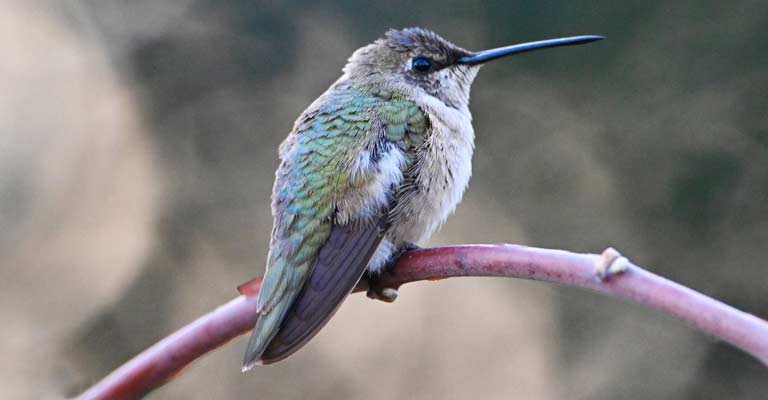
Identifying Characteristics of Black-Chinned Hummingbird
The Black-chinned Hummingbird (Archilochus alexandri) is a captivating and distinctive species that can be identified through a combination of physical characteristics and behavioral traits.
Here are eight key points to help you accurately identify this fascinating hummingbird:
Size and Shape
The Black-chinned Hummingbird is a medium-sized hummingbird with a length of about 3.5 to 4 inches (8.9 to 10.2 cm).
It possesses a slender, streamlined body and long, narrow wings, giving it a characteristic hummingbird silhouette. The bill is straight and moderately long compared to other hummingbird species.
Plumage
The male Black-chinned Hummingbird is known for its striking and iridescent plumage. It features a glossy, deep purple to black throat (gorget), which is the defining characteristic of males.
The rest of the body is generally greenish, with a slightly forked tail. Females lack the vibrant throat color and typically exhibit a more subdued greenish-gray plumage.
Gorget Coloration
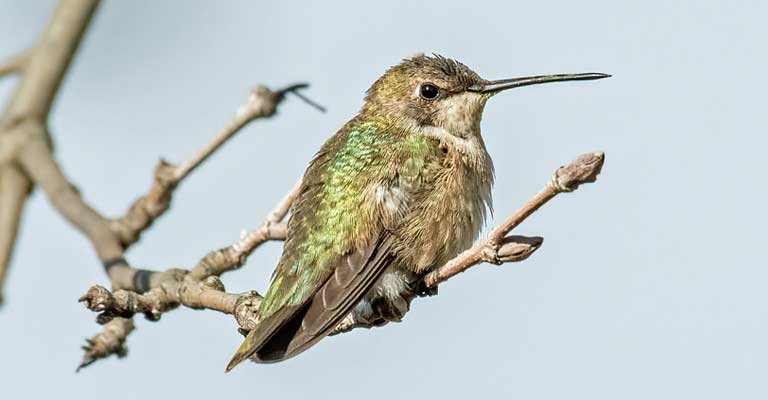
As mentioned, the male’s gorget is a key identifying feature. However, the throat color may appear black or iridescent purple, and the intensity can vary depending on the angle and lighting conditions.
The black-chinned appearance distinguishes it from other hummingbirds with similar gorget patterns.
Tail Characteristics
The Black-chinned Hummingbird has a slightly notched or forked tail. While the tail lacks the elaborate streamers seen in some other hummingbird species, this subtle feature can aid in identification.
Habitat and Range
Understanding the bird’s habitat and range is crucial for identification.
Black-chinned Hummingbirds are found in a variety of habitats, including mountain meadows, gardens, and desert scrublands, across western North America. During the breeding season, they can be observed in higher elevations.
Flight Pattern
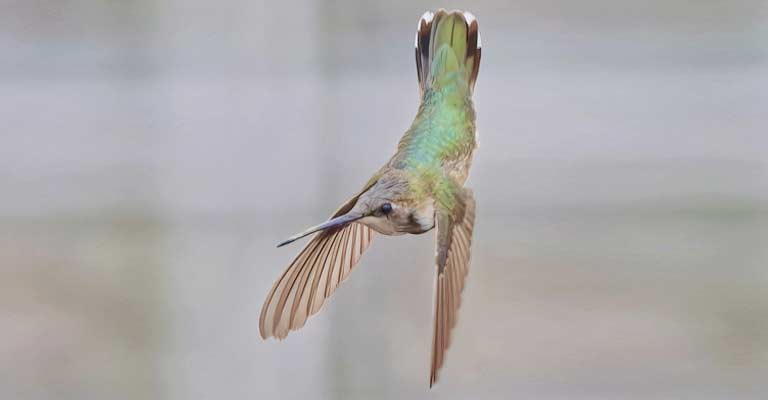
Hummingbirds are known for their agile and acrobatic flight, and the Black-chinned is no exception. They exhibit rapid wing beats and can hover in mid-air, making them easily distinguishable from other bird species.
Vocalizations
The Black-chinned Hummingbird produces distinctive vocalizations that can aid in identification. Their calls are often high-pitched and sharp, resembling a buzzing or chirping sound.
Familiarizing yourself with these vocalizations can enhance your ability to recognize this species.
Feeding Behavior
Like all hummingbirds, the Black-chinned feeds primarily on nectar, using its specialized bill and long tongue.
Observing their feeding behavior, such as hovering near flowers and sipping nectar, is a key behavioral characteristic for identification.
Identifying the Black-chinned Hummingbird involves a holistic approach that combines physical features, habitat considerations, and behavioral traits.
By paying attention to these key points, bird enthusiasts can enhance their ability to recognize and appreciate this enchanting hummingbird species in the wild.
Taxonomy of Black-Chinned Hummingbird
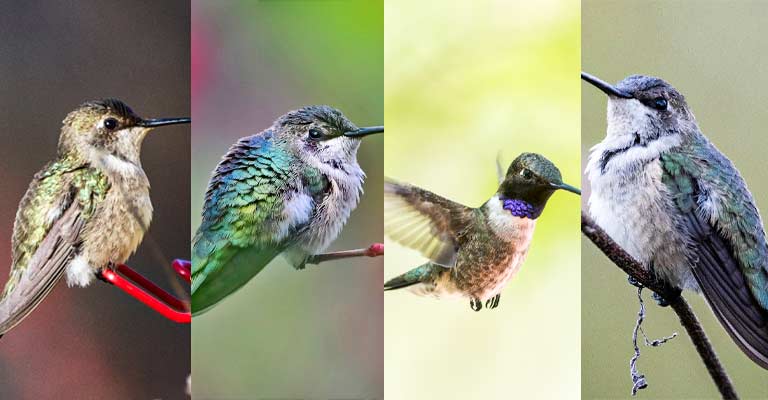
Here’s a table outlining the taxonomy details of the Black-chinned Hummingbird (Archilochus alexandri):
| Taxonomic Level | Classification |
| Domain | Eukaryota |
| Kingdom | Animalia |
| Phylum | Chordata |
| Class | Aves |
| Clade | Strisores |
| Order | Apodiformes |
| Family | Trochilidae |
| Genus | Archilochus |
| Species | A. alexandri |
This table presents the hierarchical classification of the Black-chinned Hummingbird, starting from the broad domain level down to the specific species.
The Black-chinned Hummingbird (Archilochus alexandri) belongs to the Animalia kingdom, Chordata phylum, and Aves class.
It falls within the Strisores clade, characterized by swifts and hummingbirds, and the Apodiformes order. The family is Trochilidae, emphasizing its hummingbird classification. At the genus level, it is known as Archilochus, and the specific epithet is Alexandri.
This intricate taxonomy reflects its evolutionary relationships, providing a concise overview of the Black-chinned Hummingbird’s place in the broader biological classification system.
Black-Chinned Hummingbird Life History
The Black-chinned Hummingbird (Archilochus alexandri) is a captivating species renowned for its vibrant plumage and remarkable aerial acrobatics.
This hummingbird’s life history is a fascinating tapestry woven with intricate details of its feeding habits, preferred habitats, breeding behaviors, nesting strategies, and the challenges it faces in terms of diseases and conservation.
Let’s check out the life history of the Black-chinned Hummingbird.
Food
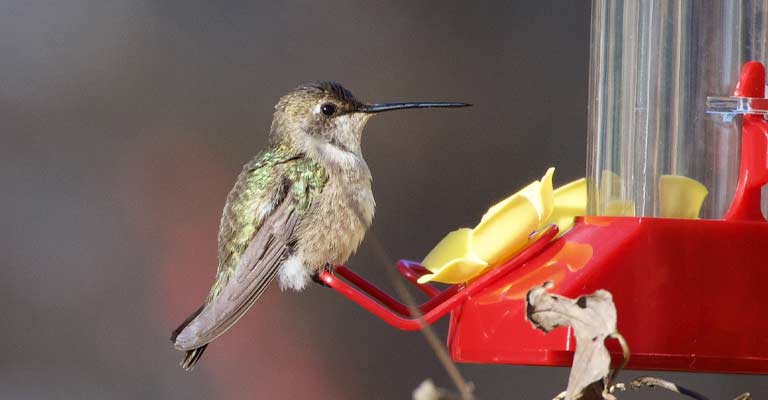
The primary diet of the Black-chinned Hummingbird consists of nectar from a variety of flowering plants. Their specialized bills and long, extendable tongues allow them to extract nectar with precision.
In addition to nectar, they also feed on small insects and spiders, providing essential proteins and nutrients. Their incredible metabolism requires a high energy intake, and they visit numerous flowers daily to meet their nutritional needs.
Habitat
Black-chinned Hummingbirds exhibit a versatile habitat selection, inhabiting a range of environments across western North America. They can be found in mountain meadows, gardens, and desert scrublands.
During the breeding season, they ascend to higher elevations, often choosing locations with abundant flowering plants to sustain their nectar-rich diet.
Range Map
The range of the Black-chinned Hummingbird extends from the western United States into western Mexico.
A range map reveals a distribution spanning from the Great Basin and Rockies to parts of California, Arizona, and New Mexico. The migration patterns of this species reflect their adaptation to varying elevations and ecosystems.
Nesting
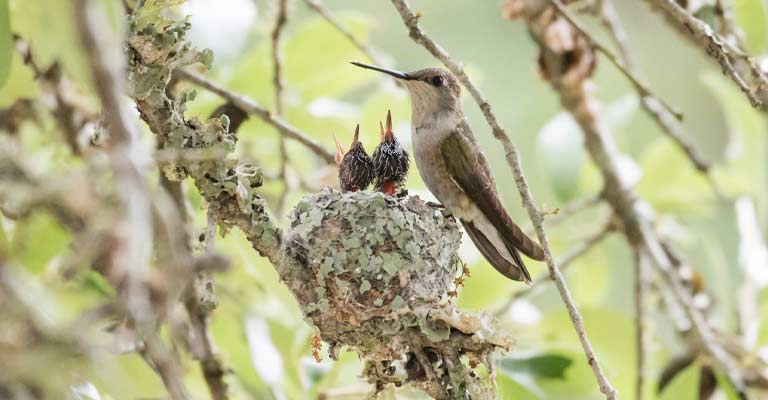
Black-chinned Hummingbirds are meticulous nest builders. Females construct small cup-shaped nests using plant fibers, spider silk, and downy materials.
These nests are often camouflaged with lichen, providing concealment from predators. Nests are typically situated on horizontal branches, offering stability for the delicate structures.
Below is a table outlining the nesting details of the Black-chinned Hummingbird:
| Nesting Details | Black-chinned Hummingbird Facts |
| Clutch Size | Usually 2 eggs per clutch |
| Number of Broods | Typically raises one brood per breeding season |
| Egg Length | Approximately 1.0 cm (0.4 inches) |
| Egg Width | About 0.6 cm (0.2 inches) |
| Incubation Period | Around 15-18 days |
| Nestling Period | Approximately 20-23 days |
| Egg Description | Small, white, and pea-sized |
| Nest Construction | Cup-shaped nest made of plant fibers, spider silk, and downy materials |
| Nest Location | Positioned on horizontal branches, often camouflaged with lichen |
| Incubation Responsibility | Females are primarily responsible for incubating the eggs |
| Parental Care | Both parents contribute to feeding and caring for the nestlings |
Breeding
Breeding occurs during the warmer months, with males engaging in elaborate courtship displays to attract females. The male’s iridescent gorget plays a crucial role in courtship rituals.
After successful mating, females take on the responsibility of incubating the two white, pea-sized eggs. The incubation period lasts about 15-18 days, and once hatched, the chicks are fed a diet of regurgitated nectar and insects.
Diseases
Hummingbirds, including the Black-chinned, are susceptible to diseases such as avian pox and various fungal infections. These diseases can impact their overall health and reproductive success, posing challenges to population sustainability.
Treatment
Conservation efforts often involve monitoring and addressing disease outbreaks among hummingbird populations.
Avian veterinarians may play a crucial role in diagnosing and treating infected individuals. Maintaining clean and well-maintained bird feeders can also help minimize disease transmission among these delicate birds.
Conservation
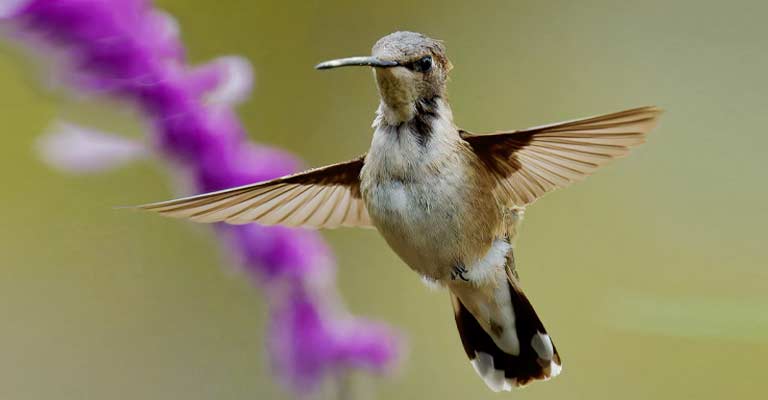
Conservation initiatives for the Black-chinned hummingbirds focus on preserving their natural habitats, ensuring the availability of suitable food sources, and raising awareness about the importance of these pollinators in maintaining ecosystem balance.
Protecting the diverse ecosystems they inhabit is essential for the long-term survival of this species.
The life history of the Black-chinned Hummingbird is a testament to the intricacies of adaptation and survival in diverse environments.
Understanding their feeding habits, nesting behaviors, and the challenges they face provides a foundation for effective conservation strategies aimed at preserving these enchanting birds for generations to come.
10 Fun Facts About Black-Chinned Hummingbirds
The Black-chinned Hummingbird (Archilochus Alexandria) is a charismatic and enchanting bird species that captivates observers with its vibrant plumage and agile aerial maneuvers.
Let’s check out the 10 fun facts that showcase the unique characteristics and behaviors that make the Black-chinned Hummingbird truly fascinating.
- Gorget Variety: Black-chinned males boast a dynamic gorget, ranging in color from iridescent purple to deep black, creating a dazzling display during courtship.
- Long-Distance Travelers: Despite their small size, Black-chinned Hummingbirds embark on impressive migrations, covering thousands of miles from their breeding grounds to wintering areas.
- High Metabolism: To support their energetic lifestyle, Black-chinned Hummingbirds have one of the highest metabolisms among birds, requiring a constant intake of nectar and insects.
- Floral Specialists: These hummingbirds specialize in feeding on tubular-shaped flowers, using their slender bills and long tongues to access nectar hidden deep within.
- Aerial Acrobats: Black-chinned Hummingbirds are skilled aerial acrobats, capable of hovering, rapid flight, and even flying backward—an impressive feat unique to hummingbirds.
- Distinctive Tail Notch: While their tails lack the dramatic streamers seen in some hummingbirds, the Black-chinned features a subtle notch or fork at the end of its tail.
- Meticulous Nest Builders: Female Black-chinned Hummingbirds exhibit remarkable nest-building skills, creating small cup-shaped nests using plant fibers, spider silk, and downy materials.
- Versatile Habitat Selection: These hummingbirds adapt to diverse environments, from mountain meadows to desert scrublands, showcasing their ability to thrive in various ecosystems.
- Vocal Communicators: Black-chinned Hummingbirds communicate using high-pitched chirps and buzzing sounds, contributing to the vibrant soundscape of their habitats.
- Keystone Pollinators: As they feed on nectar, Black-chinned Hummingbirds play a crucial role as pollinators, facilitating the reproduction of numerous plant species in their ecosystems.
Wrapping Up
The Black-chinned Hummingbird emerges as a marvel of nature, blending stunning aesthetics with remarkable behaviors.
From their vibrant gorgets to aerial acrobatics, meticulous nesting habits, and vital ecological roles, these tiny wonders enrich our understanding of avian life.
Understanding their life history, nesting details, and fun facts deepens our appreciation for the intricate balance they contribute to the ecosystems they inhabit.
As we delve into the captivating world of Black-chinned Hummingbirds, we gain insights into the resilience and adaptability of these enchanting creatures, reinforcing the importance of conservation efforts to ensure their continued existence and ecological contributions.